More than an incubator for God
The Virgin Mary is often seen as just a kind of passive incubator for God, at least by mainstream Christianity. This ignores how complex and amazing she actually is. Mary has all kinds of identities, powers and adventures and in this post I am going to share some.
Tough mother
All mothers are tough, but the Virgin Mary was really really tough. She successfully gave birth in a stable surrounded by dirt, animal shit, and no doubt bugs and ticks, and I bet the smell was horrific. She probably retched throughout the whole labour. The angel chaperone selfishly supplied no magic pain relief and she had to deal with three strange men turning up to leer as she figured out how to breastfeed. Also intact hymen.
While Jesus’s birth was undoubtedly awful it was likely nothing compared with his death. At this Mary watched her son writhe on a cross with nails through his hands and thorns on his head and blood gushing everywhere, and people laughing about it. She stuck it out until he died though, the ultimate act of motherly love and toughness.

In her guise as mother of the dying Christ, Mary is known as Mater Dolorosa/The Mother of Sorrows. This part of her life is a popular theme in art and is depicted in a variety of brutal sad ways - Mary by the cross witnessing her child’s death, Mary holding the dead Jesus on her lap and Mary with swords piercing the her heart.
Virgin Most Powerful
Among Mary’s many titles is Virgo Potens/Virgin Most Powerful. This signals her position as the supreme deity, higher even than God.
It works like this – Mary is petitioned by a human or humans for help. She responds by interceding with God/Jesus on their behalf. God wants to please his mother so fulfils her request. Essentially, Mary tells God what to do and he does it. Ergo she is the most powerful member of Heaven.
Virgo Potens also refers to Mary’s ability to make miracles (e.g. bringing forth the healing waters in Lourdes) and how she requires no assistance or permission to do so. Mary has her own discrete divine power to use whenever, wherever and however she wants. God has no say.
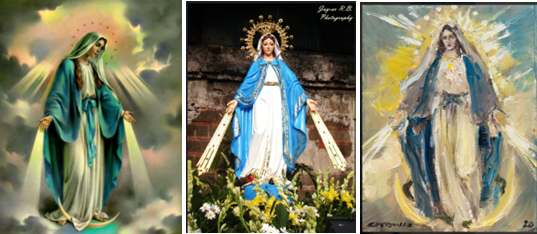
This image is titled Our Lady of the Miraculous and it’s all about Mary’s intercession and miracle-making powers. It's really common and was created by Catherine Labouré in 1830 after experiencing an apparition. Mary dictated the form and was very specific about the beams shining from her hands. She told Catherine these, "symbolize the graces I shed upon those who ask for them”. I’m pretty sure they are also vaporising power rays.
Empress of Hell
The title Empress of Hell is about Mary’s ability to intercede in the Underworld as well as in Heaven. Sometimes, in response to a petition, she’ll hassle the Devil instead of God. To do this Mary descends into Hell where she shames, debates, and even physically assaults Satan or his hordes until they do what she wants. These acts are very satisfyingly called Vengeance Miracles.
In his 1135 book, Miracles of the Blessed Virgin Mary, historian William of Malmesbury gives an example where Mary is protecting a monk from a demon. She “…redoubles her blows and makes them sharper with words, ‘Take that, and go away. I warn you and order you not to harass my monk anymore. If you dare to do so, you will suffer worse!”

Medieval manuscripts were full of vengeance miracle depictions like these ones. I am especially fond of the one on the right where Mary casually hands baby Jesus to the Archangel Gabriel then beats the shit out of Satan. Empress of Hell and working mother.
Sky Goddess
In the Book of Revelations is a most magnificent and formidable description of the Virgin Mary as a sky goddess, “A great sign appeared in the sky, a woman clothed with the sun, with the moon under her feet, and on her head a crown of twelve stars…”
The passage describes Mary’s dominion over the heavenly bodies and also that which they symbolise. Generally the sun is taken to mean Jesus/God (I love how she’s wearing him as a pelt) and the 12 stars are the ancient tribes of Israel and/or the Apostles. The moon is Mary herself.
Mary's association with the moon means many things -
- a light to lead through the darkness
- a constant, comforting, reliable presence (like how you can see the moon in the day and the night)
- a source of stability and balance (like how the Moon helps maintain the Earth’s orbital axis)
- a source of renewal and rebirth (like the 28-day lunar cycle)
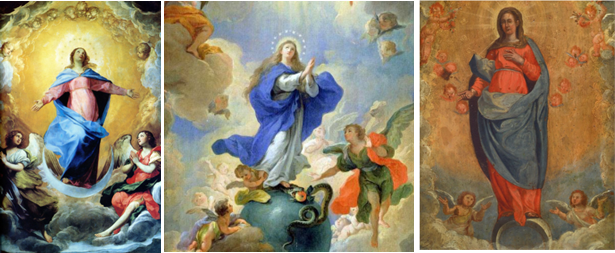
Mary “…with the moon under her feet” as described in Revelations, also has another meaning. It’s a reference to her role in the end-of-days, as a warrior with authority over all of space and time. In this guise she’s often referred to as the Woman of the Apocalypse.
As a sky goddess Mary also encompasses the astrological sign of Virgo. And it explains her penchant for wearing blue.
Star of the Sea
Another Mary-as-sky-goddess duty is to guide and protect seafarers. She does this by manifesting as a lodestar, hence her title Star of the Sea or Stella Maris. Devotion to this version of Mary is common in coastal and fishing communities and in them Stella Maris/Star of the Sea often crops up as a name for schools and churches.
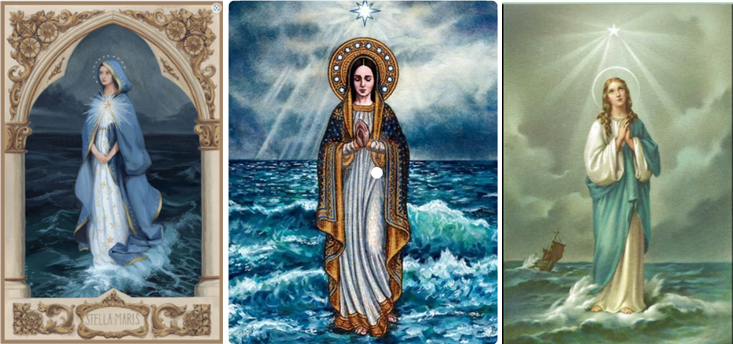
Member of the goddess sisterhood
In its mission to convert the world, Christianity co-opted a whole lot of pagan deities, assigning their powers, stories and symbols to God, Jesus, and the Virgin Mary. Through this process Mary acquired heaps of amazing attributes and with them entrance into an elite gang of formidable goddesses (probably not the Church’s intention but oh well bummer).
These goddesses come from a multitude of places and eras (a non-exhaustive list is provided in this1 footnote). All are spiritually and culturally important on their own terms and all have unique qualities, but they also share some significant ones,2 for example:
- They’re a top-tier deity, often with the title ‘Queen’ or ‘Mother’.
- They represent the feminine aspect of the divine.
- They provide protection and care, particularly for women.
- They’re responsible for motherhood, birth, renewal and nurturing.
- They have children whose father is a deity and who are sometimes conceived without physical contact.
- They are connected with the moon and sky.
- They’re tough and fearless.
The Virgin Mary is also all of these things.
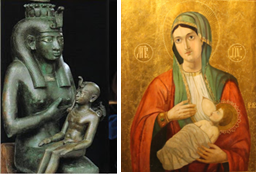
Iconography is often shared across goddesses. Here are Isis and the Virgin Mary both doing mothering.
Maryam
Maryam is the Virgin Mary’s Arabic name and the one used in the Qur'an, the sacred scripture of Islam. In this text she’s the only woman specifically mentioned and she’s referred to more often than she is in the bible (counterintuitive but true!)
Mary/Maryam also has a whole chapter devoted to telling her story, Sura 19. Some parts are the same or similar to those of the Christian tradition and some are different. The birth of Jesus is one of the different ones.
In the Qur’an Mary/Maryam gives birth without Joseph and she does so outside. She’s neither silent nor stoic during the experience which is described as very very very painful. At one point she even yells “Oh, if only I had died before this and passed into oblivion!” God turns up and acts as kind of a midwife, providing Mary/Maryam with sustenance (water and dates) and just generally caring for her throughout the labour.
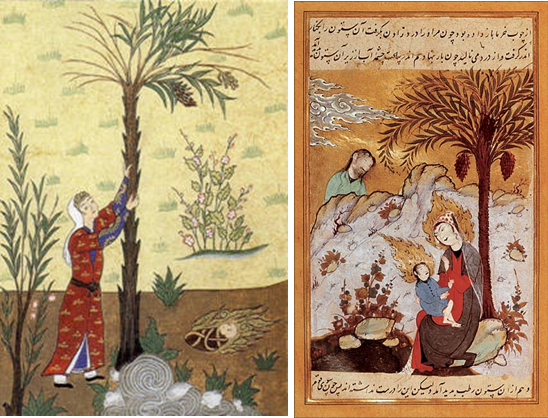
Here are some pre-twentieth century before and after the birth images. On the left is Mary in labour, shaking God's palm tree to get the dates to fall. On the right are mother and child, both doing well. Note God peering at them over the rocks all proud and happy. In Islam iconography flames are a symbol of divinity, similar to halos.
Other faiths
Muslims are not the only non-Christians who revere the Virgin Mary. She is important in many different religions and cultures where she embodies many different things, transcending and transforming orthodox doctrine.
For example in some sects of Taoism Mary manifests as one who meditates with her heart, helping to reveal the spiritual potential of humankind. Some Buddhists perceive her as an incarnation of of the bodhisattva Guanyin, a feminine deity of compassion. And for some Hindus she is part of a whole goddess pantheon.
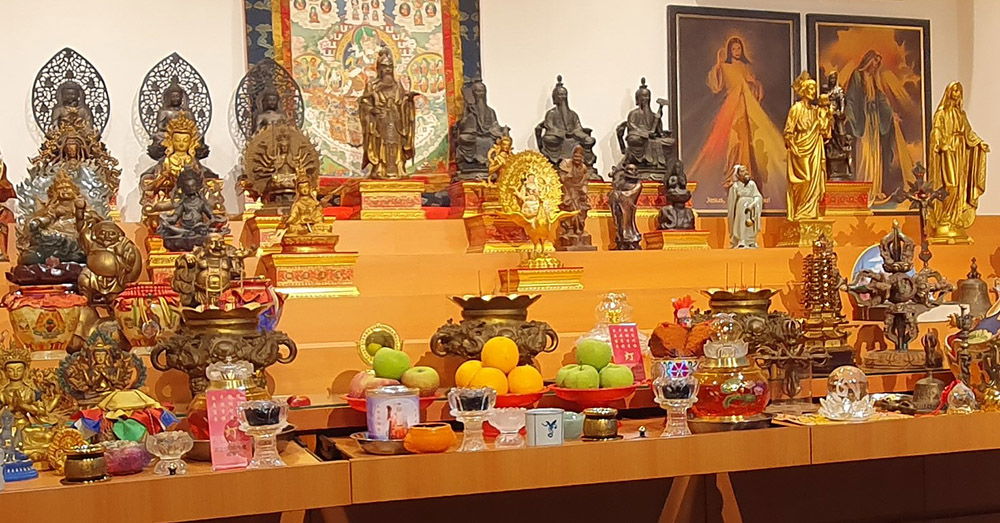
A Taoist altar featuring many venerated deities including Mary (top right).
La Negrita
Many localities and communities have their own Virgin Mary stories, experiences and beliefs. One I really like is that of La Negrita / Dear Black One from Cartago, Costa Rica. Here’s a really quick (inadequate) version –
In 1635 a woman named Juana Pereira found a small black statue of the Madonna sitting on a rock and took it home. Later, passing the same rock, she found what she thought was another. Juana took this one home and saw that the first statue had disappeared. This occurred three times and Juana realised it was the same statue, moving around. A bit freaked out, she passed it onto local priest. He put it in a box and again it escaped, returning to the rock. By this time it was pretty obvious where the Madonna wanted to be, and the rock became a shrine.
All Marian apparitions are important but this one particularly so because the statue was Black. Juana Pereira was a woman of colour living a racially segregated life. As La Negrita/ Dear Black One Mary demonstrated her love and support for a black community, and her determination to live within it.
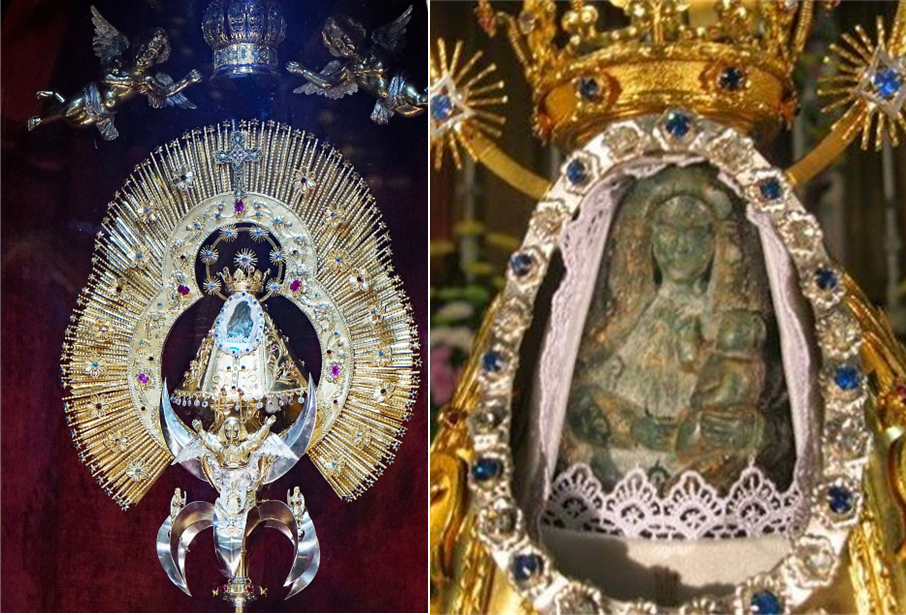
La Negrita/Dear Black One currently lives in Our Lady of the Angels Basilica, Cartago, Costa Rica. She has her own festival and is visited by hundreds of thousands of people each year.
The Black Madonna
La Negrita is part of a broader Black Madonna tradition. In this context 'Black Madonna' refers to a type of medieval Marian statue or painting with dark or black features, with origins that are mysterious. Hundreds exist in churches, monasteries and convents around the world.
There are various fascinating theories about the Black Madonna's existence and meaning –
- She is displaying solidarity with, and love for, non-white cultures and communities (as with La Negrite)
- She was not originally dark but has become so with age or as the result of exposure to something (e.g. candle smoke)
- She is a representation of the Bride in the Song of Solomo,: “I am black, but comely, O ye daughters of Jerusalem.”
- She is a link to the ancient pre-Christian worshipping of Mother Earth and other female deities (that goddess gang I described earlier), with black as the colour of soil and therefore fertility and growth
- She is an expression of an ancient cultural memory connecting humanity back to its roots in Africa
- She is an embodiment of sadness. In Aramaic (the language of Jesus) black means 'sorrowful'.
None of these are mutually exclusive.
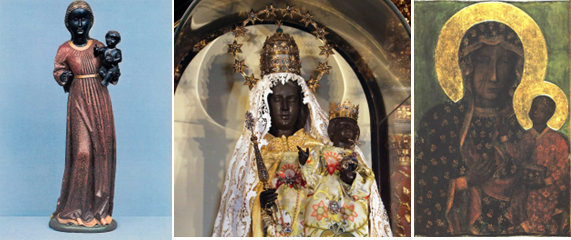
Here are the Black Madonnas of Einsieden (Switzerland), Kupfergasse (Germany) and Czestochowska (Poland) respectively.
There's a lot more cool Virgin Mary stuff I could share but I'm quite tired. I think she'd understand.
1Isis (Egypt), Artemis (Greece), Diana (Rome), Asherah (Canaanite), Cybelle (Phrygia) Sophia (Gnostic), Guanyin (Chinese), Sri Laksmi (Sanskrit), Apirami (Tamil), Ala (Africa), Hina (this is a name shared by a number of Polynesian deities from different places).
2Not every single goddess shares every single attribute in the list but there’s enough overlap.